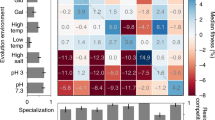Summary
The fitness distribution of new mutations inSaccharomyces cerevisiae strain Montrachet was determined for cells on agar irradiated for four periods of time with ultraviolet light. The fitness distributions were obtained by converting a large number of colony diameters into relative fitnesses. The distributions were then used to perform a computer simulation with the purpose of predicting the potential of a stock culture to increase in general fitness through selection, given a frequency and magnitude of mutations.
Similar content being viewed by others
References
Aieba, S., M. Shoda and M. Nagatani. 1968. Kinetics of production inhibition in alcohol fermentation. Biotechnol. Bioeng. 10: 845–864.
Bazua, C.D. and C.R. Wilke. 1975. Ethanol effects on the kinetics of a continuous fermentation withS. cerevisiae. Chem. Cong. NA (Mexico) 1: 28.
Bodmer, W.F. and L.L. Cavalli-Sforza. 1972. Variation in fitness and molecular evolution. In: Proceedings of the Sixth Berkeley Symposium on Mathematical Statistics and Probability (Le Cam, L.M., J. Neyman and E.L. Scott, eds.), University of California Press, Berkeley and Los Angeles.
Boulton, R. 1980. The prediction of fermentation behavior by a kinetic model. Am. J. Enol. Vitic. 31: 40–45.
Cottrell, S.F. 1981. Mitochondrial DNA synthesis in synchronous cultures of the yeast,Saccharomyces cerevisiae. Exp. Cell Res. 132: 89–98.
Cottrell, S.F. and C.J. Avers. 1971. Mitochondrial activities in synchronous cultures of Baker's Yeast. In: Autonomy and Bioenergetics of Mitochondria and Chloroplasts (Boardman, N.K., A.W. Linnane and R.M. Smillie, eds.), North Holland Publishing Co., Amsterdam.
Crow, J.W. 1972. Darwinian and non-Darwinian evolution. In: Proceedings of the Sixth Berkeley Symposium on Mathematical Statistics and Probability (Le Cam, L. M., J. Neyman and E.L. Scott, eds.), University of California Press, Berkeley and Los Angeles.
Holzberg, I., R.K. Finn and K.H. Steinkraus. 1967. A kinetic study of the alcohol fermentation of grape juice. Biotechnol. Bioeng. 9: 413–427.
King, J.K. 1972. The role of mutation in evolution. In: Proceedings of the Sixth Berkeley Symposium on Mathematical Statistics and Probability (Le Cam, L.M., J. Neyman and E.L. Scott, eds.), University of California Press, Berkeley and Los Angeles.
Masatoshi, N. 1975. Molecular Population Genetics and Evolution. North Holland Publishing Co., Amsterdam.
Meiering, A.G., R.E. Subden and C.L. Penn 1982. Microprozessorsteuerung der Äthanolgärung. Grund. C. Landtechnik. (Verein Deut. Ing.) 32: 124–130.
Mota, M., P. Strehaiano and G. Goma. 1984. Studies on conjugate effects of substrate (glucose) and product (ethanol) on cell kinetics during fermentation on different yeast strains. J. Inst. Brew. 90: 359–362.
Scopes, A.W. and D.H. Williamson. 1964. The growth and oxygen uptake of synchronously dividing cultures ofSaccharomyces cerevisiae. Exp. Cell Res. 35: 361–371.
Snow R. 1979. Toward genetic improvement of wine yeast. Am. J. Enol. Vitic. 30(1): 33–37.
Subden, R.E. 1983. Wine yeasts. Dev. Ind. Microbiol. 24: 221–229.
Subden, R.E., R.L. Charlebois and C.K. Carey. 1987. Selection in yeast. I. Assessing genetic stability and relative fitness of commercial yeasts. J. Ind. Microbiol. 2: 159–165.
Timofeef-Ressovsky, N.W. 1940. Mutations and geographic variation. In: The New Systematics (Huxley, J., ed.), Oxford University Press, London.
Wickerham, L.J. 1951. Taxonomy of yeasts. Tech. Bull. U.S. Dep. Agric. No. 1029.
Williamson, D.H. and A.W. Scopes. 1960. The behaviour of nucleic acids in synchronously dividing cultures ofSaccharomyces cerevisiae. Exp. Cell Res. 20: 338–349.
Williamson, D.H. and A.W. Scopes. 1961. The distribution of nucleic acids and protein between different sized yeast cells. Exp. Cell Res. 24: 151–153.
Williamson, D.H. and A.W. Scopes. 1962. A rapid method for synchronizing division in the yeast,Saccharomyces cerevisiae. Nature 193: 256–257.
Author information
Authors and Affiliations
Rights and permissions
About this article
Cite this article
Charlebois, R.L., Subden, R.E. & Carey, K. Selection in yeast II: The fitness distribution of new mutations inSaccharomyces cerevisiae and its use in a computer simulation. Journal of Industrial Microbiology 2, 167–174 (1987). https://doi.org/10.1007/BF01569424
Received:
Revised:
Accepted:
Issue Date:
DOI: https://doi.org/10.1007/BF01569424




